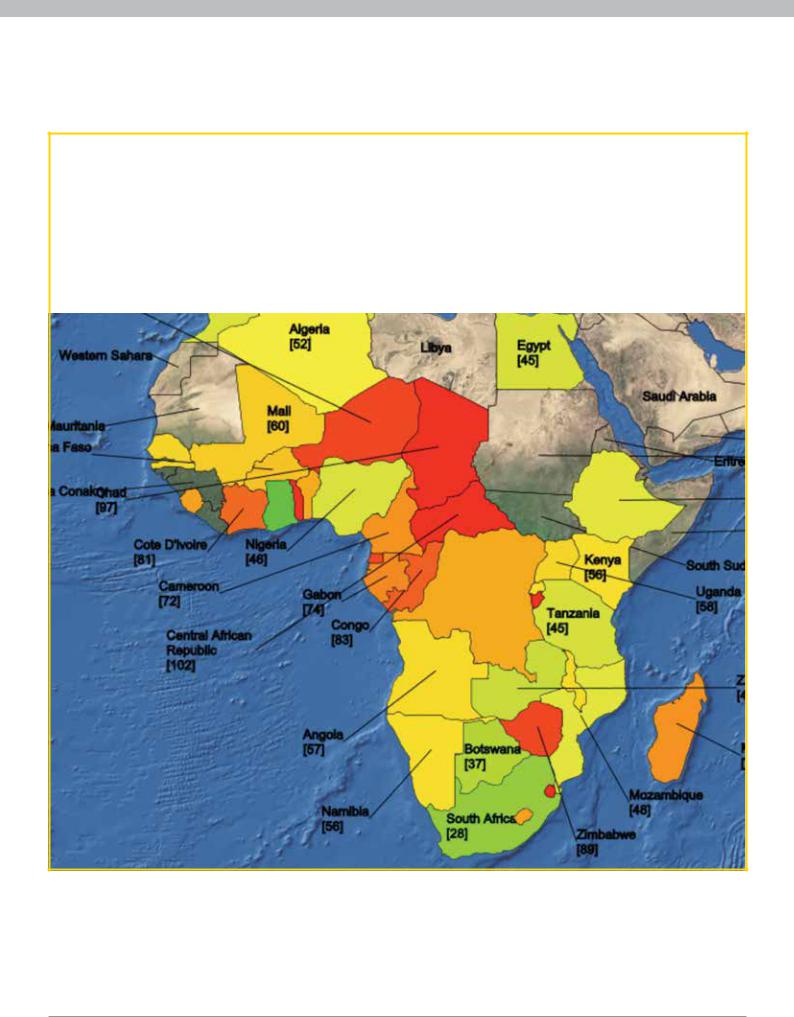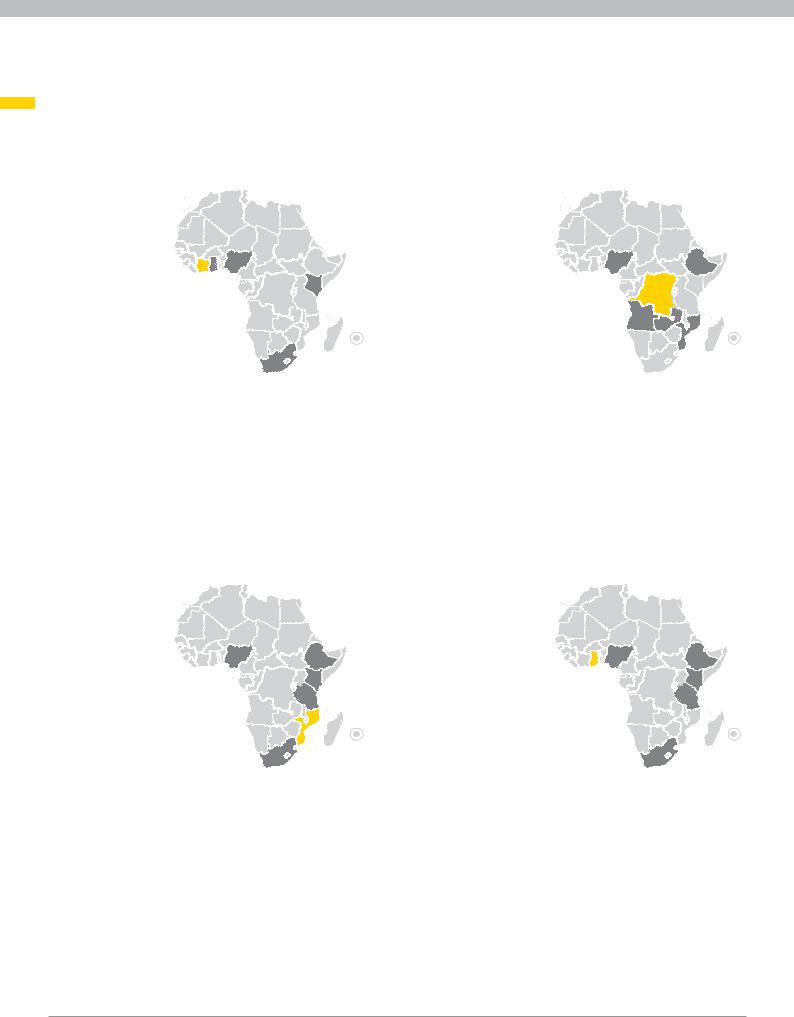
130130 SGF Thought Leadership email version
.pdf
“We’ve been investing in Africa for over a century. We don’t do anything else. There isn’t a starting point that says, ‘shall I invest in Africa’?; we have nothing else to do all day! Grabbing opportunities while mitigating risk has been Lonrho’s approach to investing in Africa. As a result, there are very few markets we would not consider opportunities in. But it is critical to take time to understand the market, the opportunities, the regulations, the government, the people, the partnerships ... if you take the time to build that understanding, most risks become far more manageable, and your primary focus can be on realizing the opportunity.”
David Armstrong, Finance Director, Lonrho
Figure 3: Growth rate versus ease of business: no one is saying Africa is risk free
Fast growing does not mean easy
Ranking |
Country |
Estimated growth |
Ease of doing business ranking |
Corruption perception ranking |
Rated out of 185 countries: the smaller the number, the easier to work in
Rated out of 176 countries: the lower the number, the less corrupt the country is perceived to be
1 |
São Tomé and Principe |
31.50% |
|
|
|
|
|
|
|
|
|
|
|
|
|
|
|
|
|
|
|
|
|
|
|
160 |
|
|
72 |
|
|
|
|
|
|
|
|
||||||||
|
|
|
|
|
|
|
|
|
|
|
|
|
|
|
|
|
|
|
|
|
|
|
2 |
South Sudan |
19.85% |
No data |
|
|
|
|
|
|
No data |
||||||||||||
|
|
|
|
|
|
|
|
|
|
|
|
|
|
|
|
|
|
|
|
|
|
|
3 |
Guinea |
16.27% |
|
|
|
|
|
|
|
|
|
|
|
|
|
|
|
|
|
|
||
|
|
|
178 |
|
154 |
|
|
|||||||||||||||
|
|
|
|
|
|
|
|
|
|
|
|
|
|
|
|
|
|
|
|
|
|
|
|
|
|
|
|
|
|
|
|
|
|
|
|
|
|
|
|
|
|
|
|||
8 |
Libya |
10.38% |
No data |
|
|
|
|
160 |
|
|||||||||||||
|
|
|
|
|
|
|
|
|
|
|
|
|
|
|
||||||||
|
|
|
|
|
|
|
|
|
|
|
|
|
|
|
|
|
|
|
|
|
|
|
11 |
Rep. of the Congo |
9.31% |
|
|
|
|
|
|
|
|
|
|
|
|
|
|
|
|
|
|
|
|
|
|
|
183 |
|
144 |
|
|
|
||||||||||||||
|
|
|
|
|
|
|
|
|
|
|
|
|
|
|
|
|
|
|
|
|
|
|
12 |
Mozambique |
9.29% |
|
|
|
|
|
|
|
|
|
|
|
|
|
|
|
|
|
|
|
|
|
|
|
146 |
|
|
|
|
123 |
|
|
|
|
|
|||||||||
|
|
|
|
|
|
|
|
|
|
|
|
|
|
|
|
|
|
|
|
|
|
|
13 |
Zambia |
9.24% |
|
|
|
|
|
|
|
|
|
|
|
|
|
|
|
|
|
|
|
|
94 |
|
|
|
|
|
88 |
|
|
|
|
|
|
|
|||||||||
|
|
|
|
|
|
|
|
|
|
|
|
|
|
|
|
|
|
|
|
|
|
|
16 |
Ghana |
8.92% |
|
|
|
|
|
|
|
|
|
|
|
|
|
|
|
|
|
|
|
|
64 |
|
|
|
|
|
|
64 |
|
|
|
|
|
|
|
|
|
||||||
|
|
|
|
|
|
|
|
|
|
|
|
|
|
|
|
|
|
|
|
|
|
|
17 |
Ivory Coast |
8.63% |
|
|
|
|
|
|
|
|
|
|
|
|
|
|
|
|
|
|
|
|
|
|
|
177 |
|
|
130 |
|
|
|
|
||||||||||||
|
|
|
|
|
|
|
|
|
|
|
|
|
|
|
|
|
|
|
|
|
|
|
19 |
Gambia |
8.35% |
|
|
|
|
|
|
|
|
|
|
|
|
|
|
|
|
|
|
|
|
|
|
|
147 |
|
|
|
|
105 |
|
|
|
|
|
|
||||||||
|
|
|
|
|
|
|
|
|
|
|
|
|
|
|
|
|
|
|
|
|
|
|
20 |
Rwanda |
8.23% |
|
|
|
|
|
|
|
|
|
|
|
|
|
|
|
|
|
|
|
|
52 |
|
|
|
|
|
|
|
50 |
|
|
|
|
|
|
|
|
|
|
||||
|
|
|
|
|
|
|
|
|
|
|
|
|
|
|
|
|
|
|
|
|
|
|
Source: Growth: BusinessInsider 24 October 2012 from IMF World Economic Outlook, estimates for 2013-2017 CAGR (world rankings)Doing Business 2012 rankings out of 185: the smaller the number, the easier to work in: Transparency Intl corruption perception index 2012: out of 176 countries; the lower the number, the “cleaner”
the country
8

“Strategy is often easily expressed in broad terms, but an understanding
of the key drivers underpinning a strategy is required before venturing into Africa as a new investment destination. Moving to execution is sometimes cumbersome, frustrating and slow.
As Africa emerges as the ‘growth’ continent, investors need to remain patient, adaptive and committed in order to achieve meaningful and profitable results.”
Fradreck Shoko, Co-Head, Africa Corporate
Finance, Standard Bank
On a composite country risk index, the group of top ranked African countries benchmark well against other Rapid-growth markets, with eight of them ranked above Brazil and India, the next highest ranked of the BRICs after South Africa. On the same risk index, 9 African countries rank ahead of China, and 20 ahead of Russia.
Figure 4: Best ranked African versus BRIC economies: no more risky, perhaps a lot less so
consistentlyAfrica |
|
|
1. Chile |
13. Thailand |
||||
undervalued |
|
|
|
|
|
|
|
|
|
2. Mauritius |
|
|
14. Namibia |
|
|
||
|
|
|
|
|
|
|
||
|
|
|
|
|
|
|
|
|
|
|
|
3. Malaysia |
15. Ghana |
|
|
||
|
|
|
|
|||||
|
|
|
|
|
|
|
|
|
|
|
|
4. Botswana |
|
|
16. Turkey |
||
|
|
|
|
|||||
|
|
|
|
|
|
|
|
|
|
|
|
5. Qatar |
17. Colombia |
||||
|
|
|
|
|
|
|
|
|
|
|
|
6. South Africa |
|
|
18. Mexico |
||
|
|
|
|
|||||
|
|
|
7. South Korea |
19. Tunisia |
|
|
||
|
|
|
|
|||||
|
|
|
|
|
|
|
|
|
|
|
|
8. Poland |
20. Zambia |
|
|
||
|
|
|
|
|||||
|
|
|
|
|
|
|
|
|
BRIC |
|
9. United Arab Emirates |
21. Brazil |
|
|
|||
|
|
|||||||
|
|
|
|
|
|
|
||
10. Saudi Arabia |
22. India |
|
|
|||||
|
|
|
||||||
|
|
|
|
|
||||
|
|
|
|
|
|
|
|
|
|
|
|
11. Czech Republic |
25. China |
|
|
||
|
|
|
|
|||||
|
|
|
|
|
|
|
|
|
|
|
|
|
|
||||
|
|
|
12. Rwanda |
|
|
39. Russia |
|
|
|
|
|
|
|
|
|
|
|
Source: Ernst & Young Africa by numbers 2012
Perspective matters. Media portraits of insurgencies and conflicts in some African countries belie the fact that some highly rated non-African investment destinations also face such problems, yet are not viewed with the same risk lens. For example, Turkey occupies a troubled neighborhood and has suffered a long-running separatist conflict, yet is rightly widely perceived as a viable investment destination. By contrast, some investors point to northern Nigeria’s security issues without accounting for the ways in which these may, conceptually, be no worse, or indeed less, significant than Turkey’s challenges. There is also a need to adopt ways of perceiving risk that look beyond country-level risk or opportunity rankings. Large expanses of relative stability exist in ostensibly risky African countries, just as pockets of instability exist in otherwise stable countries with low-risk ratings.
9Strategic Growth Forum | From strategy to execution

“Tullow’s success in Africa has not happened overnight; it has been very much about perseverance. It does take time. Preparation and planning is critical to success. You may also not necessarily succeed first time around. We use the ‘T’ word: TENACITY; with any frontier, you have to be prepared to try, and try again.”
Brian Glover, Strategy Director, Tullow Oil
10

“The Nigerian legal and regulatory landscape is fluid and constantly
changing, and ignoring its complexities could lead to disaster.
Red tape, a slow judicial process and a high cost of compliance all mean that, from the very outset, firms should find an experienced and competent local counsel,
with specialist knowledge and expertise in the areas they need help with.”
Colin Egemonye, Egemonye Associates
2. Planning
It is axiomatic that Africa’s complexities and challenges, combined with increasing competition to access its many opportunities, put a premium on both planning in the strategy formation phase and flexibility during implementation. Continuously monitoring and evaluating one’s strategy and planning for contingencies is particularly crucial.
Indeed, a macro factor for successful strategy-execution transitions in African settings is to avoid viewing strategy and planning in a static fashion. Firms whose strategic approaches emphasise patience, persistence and pragmatism, together with a looping or continuous learning process, have proven most adept at flourishing in dynamic African settings.
As some investors have discovered, there are rarely any shortcuts to succeeding in Africa. Many features of the continent make it a difficult place to operate:
•Infrastructure gaps. Transport networks and electricity, in particular, are lacking across the continent.
•Bureaucratic bottlenecks. The number of processes required to negotiate much of the continent’s bureaucracy means Africa is a tough place to plan ahead.
•Undeveloped consumer demand. Demand across sectors and countries has not reached the levels of sophistication seen elsewhere in the world.
These are undeniably challenges, yet they are all issues that also reward flexible, innovative and unconventional approaches.
Much is made of Africa’s mobile phone revolution and the range of financial products (along with other services) that now use mobile platforms.
The opportunity is to position one’s firm to make similar leaps, as this sector did, to bypass well-known constraints and move to unlock potential, whatever the sector. A degree of “planned pragmatism” goes far.
Unreliability of data
Completion of strategy rollout means learning to live with complexity. This is illustrated clearly in relation to the paucity of reliable and accurate official data from most African countries.
11 Strategic Growth Forum | From strategy to execution

Although new entrants must work with what data is available, many existing investors rely more on their own monitoring and reporting processes. Much of the available intra-firm data points unequivocally to the potential for highly profitable and sustained business ventures in countries where official datasets are poor.
From the perspective of those entering African markets, using this unreliable data is an unavoidable necessity. However, a careful eye must be kept on quality control at all times. The ability to critically think around a data set, and measure it against recent economic and geopolitical events, is particularly crucial.
Maintaining an objective, qualitative approach, in addition to quantitative analysis of the statistics, can shed some light on whether a given data set is reliable or not.
Additionally, as Ernst & Young’s Africa Business CenterTM shows with its Growing Beyond Borders toolset, there is a fast-improving ability to make sense of Africa’s data deficits and produce workable
numbers. Despite Africa’s data problems, it is possible to put together reasonable indicators or proxies and plan on the basis of these. Using both qualitative and quantitative tools of this type, one can still execute an effective strategy despite imperfect information.
“The demand for African macroeconomic statistics, for all sorts of purposes, remains strong, despite the inadequacies of the supply.
A new approach is needed. In terms of quantity, more countries need to complete the basic tables of the national accounts, and to reduce the publication time lag, which sometimes exceeds seven years.
In terms of quality, there is a need for a new pan-African institution to organize statistical experts to evaluate the quality of statistics.
Bona fide users would be greatly assisted by the introduction of a grading system that distinguished soundly based numbers from the unsound.”
Professor John Toye, Institute of Development Studies, University of Oxford, and Oxford Analytica Region Head
12

Figure 5: A composite heat map from Ernst & Young’s Growing Beyond BordersTM (GBB) tool
Growing Beyond BordersTM
In identifying and prioritizing markets for investment, there should be a thorough process of fact-based due diligence, including sector-specific tax, legal and regulatory factors (which are often material enabling or constraining factors in the African context).
A key challenge in such a process is the apparent scarcity of information. However, once one starts digging a bit, there is actually a large quantity of Africa-related data available. The challenge more often is that data is fragmented across various
sources, and so can be difficult to collate and present in a coherent and meaningful way. We therefore developed Growing Beyond BordersTM, a map-based interactive software tool, with a twofold capability to help our clients address this challenge.
First, it provides an information portal, aggregating a range of indicators, indices and other data from various sources
together for easy access. Second, we have found that the visual presentation of the information via the map-based interface is intuitive for most people, and provides a commonly understood reference point for strategic discussion on investment decisions.
A composite “heat map” from Ernst & Young’s Growing Beyond Borders™ tool, showing relative market attractiveness (from green being more attractive to red being less attractive) across a range of indicators of opportunity and risk.
13 Strategic Growth Forum | From strategy to execution

3. Places
If there is one word for Africa’s 50+ countries, it is “diversity.” Understanding the local perspective on business environment and regulatory issues, infrastructure provisions and the labor market are obvious factors to prioritize when setting a strategy for
entering a market. The wider consideration involves identifying key regional nodes as platforms from which to expand further. Regional integration — the lack of which has, for so long, been the biggest disincentive to many global firms and brands — could create new pooled and networked markets.
Effective prioritization and emphasis on the places in and from which one seeks to grow will likely prove a decisive macro factor in tapping African opportunity:
•Light footprint? Familiar debates about the merits of regional investment gateways or hubs, such as South Africa, Kenya or Nigeria, have led some to question the concept. Depending on the sector, it is true that it may be possible to skip the supposed necessary first step of establishing a foothold in a “gateway” destination.
•Strong springboard. Working with the gateways or hubs may not always be a requirement, but executing a strategic decision to grow strongly and sustainably on the continent will typically
continue to involve judicious use of gateway settings and services.
The challenges associated with multiple jurisdictions create opportunities to think of less conventional regional market groupings, including urban corridors and clusters, cultural affinity and market growth patterns, in search of investment synergies.
If further progress is achieved on freer, faster intra-African trade, and on the regional integration agenda more broadly, then one of the principal constraints on investment in Africa would become a catalyst for rapid transformation. An example of regionalism that is often overlooked in Anglo-centric approaches to Africa is the 14-country West and Central African CFA franc-zones, the single currencies of which are pegged to the euro. Both CFA franc-zone blocs have proved remarkably enduring and stable, and are undergoing a concerted institution-building agenda designed to ensure their greater resilience to any further external shocks. The greater financial sector integration within markets suggests that it is at least conceivable that various “unmapped” settings will become more attractive.
“Developments elsewhere in the world over the last 20 years, particularly
in developing Asia, provide strong evidence of how to overcome obstacles and succeed in the development race. Even in the absence of local data, Africa can use the experience of others to demonstrate what it might achieve. What might emerge in a decade’s time will
not be identical to China, for example, but it will be the unique foundation for an orderly and integrated pan-African economic system.”
Vanessa Rossi, Oxford Analytica Region Head
14

Figure 6: Matrix of sectors and places: how would this list look in five years’ time?
Sub-Saharan Africa investment destinations: stimulating debate
Financial services |
|
Agriculture |
|
|
||
1 |
South Africa |
|
1 |
Nigeria |
|
|
2 |
Mauritius |
|
2 |
Ethiopia |
|
|
3 |
Nigeria |
|
3 |
Zambia |
|
|
4 |
Kenya |
5 3 |
4 |
Mozambique |
1 |
2 |
5 |
Ghana |
5 |
Angola |
|||
|
Wildcard |
4 |
|
Wildcard |
|
|
|
|
|
|
|
|
|
||
|
? Ivory Coast |
2 |
|
? DRC |
5 |
3 |
4 |
|
|
|
|
|
|||
|
|
1 |
|
|
|
|
|
South Africa’s robust sector will remain by far the biggest. Nigeria’s post-2009 consolidation continues; along with Kenya and Ghana, it looks set to register strong financial sector growth, including retail banking.
•Is it suprising that Mauritius ranked too highly?
•What are Abidjan’s prospects as a regional center?
Tanzania could easily make this list. Before 1975, a major producer with 35 million hectares cultivated, Angola’s inclusion is arguable for long-term investment plays: almost half Luanda’s food requirement is imported.
•Shouldn’t one include DRC if looking long term?
•What about Madagascar or the Mano River countries?
Power |
|
|
Transport |
|
|
||
1 |
South Africa |
|
|
1 |
Nigeria |
|
|
2 |
Nigeria |
|
|
2 |
South Africa |
|
|
3 |
Tanzania |
|
|
3 |
Kenya |
|
|
4 |
Kenya |
2 |
|
4 |
Tanzania |
1 |
|
5 |
Ethiopia |
5 |
5 |
Ethiopia |
5 |
||
|
Wildcard |
4 |
|
Wildcard |
3 |
|
3 |
|
4 |
||
|
? Mozambique |
|
? Ghana |
||
|
|
|
|
||
|
|
1 |
|
|
2 |
Eskom’s a major player, particularly in Southern Africa. Despite renewable, nuclear or shale bids, private contribution to South Africa’s overall capacity remains small — for now. Nigeria’s ambitious prioritization plans are well under way.
Ethiopia: hydropower; Kenya: geothermal?
• Is Ghana’s gas-to-power plans proceeding smoothly?
Although Nigeria has had success with port successions, it still lacks good road and rail links. South Africa has ambitious infrastructure spending plans but clarity is still required about the role of the private sector financing. Kenya is attractive as part of a wider East Africa infrastructure growth outlook.
•What impact do emerging regional transport corridors have on this ranking?
15 Strategic Growth Forum | From strategy to execution

The East African community (EAC) is frequently hailed for its progress in reducing barriers to creating a more attractive pooled common market. One lesson from the EAC is how chambers of commerce or other industry-specific groupings have not necessarily waited on inter-governmental processes,
but have led the integration of their own mutual interests, in a way that government can later follow with regulatory recognition.
For example, if private tourism operators in three to four different countries can negotiate flexible “code-share”-style arrangements, this could prompt governments to act on the idea of a regional tourist visa that minimizes hassle for foreign travelers. The same sort of advance — where industry leads government, rather than being passive recipients of reform — is no doubt possible in a wide range of sectors.
Measuring progress on regional trade
The example of one border post illustrates both the need to plan for positive contingencies (easier cross-border trade), and the procurement opportunities arising as funding is increasingly directed to unlocking key infrastructure bottlenecks.
Zambia is a crucial node in central-southern Africa trade and supply routes, from Durban to Dar-es-Salaam, while resource-rich southern DRC cannot rely on Atlantic-facing export and import routes.
•Before. Prior to the construction of Kasumbalesa border facility, truckers exporting mineral cargoes from the DRC’s Katanga province, or importing mining equipment and other goods from east African seaports, took an average of seven days to clear the border.
•After. The 25 million dollar border post, which opened in 2011, has cut transit times to four hours, and now services some 500 trucks a day.
Moreover, it is notable that the project resulted from private sector-led proposals, not state-led competitive tenders. On its performance, the private contractor has since secured tenders to build six more Zambian border crossing points.
Executing long-term macro-strategy thus requires seeing the scope for current constraints to become avenues of opportunity. Meanwhile,
Kasumbalesa shows how rapid transformation can be when it does occur in African markets. The challenge is to identify physical and commercial
bottlenecks, whose alleviation could scale-up prospects for strategic success.
In the next decade, the more agile and adaptive firms will be found thinking in less conventional ways, looking below and above the country level to focus strategy at the city and regional level. Of course, one can tap into growth in niche sectors, or a particular city or country, without having to roll out across the continent: an “Africa strategy” could prove unwieldy.
The pressure within firms to find ways not to miss out on Africa’s growth can distort implementation of their Africa strategy. Some places are genuinely more attractive than others: consolidation in these places is as legitimate a tactic for tapping African growth as expansion.
“Due to the challenge and high cost of marketing through traditional media channels in Africa, many blue chip companies have moved toward strategies of ‘experiential marketing.’ By using roadshows, companies have been able to expose their brands to a higher number of consumers in some off- the-beaten-track locations.”
Matthew Fitzsimons, co-founder, Big Eye Branding
16

“Working closely with governments as they reform and strengthen structures to facilitate capital inflows is critical … sluggish growth elsewhere offers us
opportunities to produce sound policy reforms, attractive incentives and favorable business environments to accelerate FDI inflow — and for investors to take advantage of these moves to achieve strategic growth aims.”
Mustafa Bello, CEO, Nigerian Investment Promotion Commission
4. Partnerships
In almost every sector, success in translating strategy into execution will depend on effective partnerships with all levels of government (from local authorities to regional secretariats). This process is often as difficult and time-consuming as it is vital:
•Context. Governments are under increasing pressure to demonstrate improvements in local quality of life and skills-transfer, deriving from the presence of foreign business. Some firms will hope that the narrow pursuit of their business objectives suffices in the eyes of host governments; however, those that conceive of
a longer-term strategy will, within what is reasonable for their size and sector, see and articulate their objectives, as designed to help the local and national development and aspirations of their host country.
•Convention. Some firms will continue to complain about poor quality regulators and government counterparts, without acting on the problem; more dynamic firms will re-think conventional distribution of roles, helping government officials in appropriate ways that, in turn, make it easier to conduct business. Some firms will poach the best government officials to work in-house; firms with the longer term in mind might see the value of refraining from
emptying government of its more effective officials. Unconventional mindsets like these could alter ease of doing business in the longer term.
From pre-country entry planning to day-to-day operations, business will find many (if not all) African governments increasingly pragmatic and receptive to engagement. Of course, closer government relations carry regulatory and reputational risks: it
is possible (and, as a matter of principle, preferable) to do well at fostering good government relations, while also doing good by avoiding exposure to potentially damaging corruption processes.
Cooperation or competition?
There is another sense in which partnerships will prove decisive. The debate in recent years on Chinese and other “new” players in Africa’s extractive, construction and retail sectors has tended to view such issues only in terms of strategic and commercial competition. This obscures the potential for judicious collaboration in many sectors:
•Sharing. For example, it is widely thought that Chinese and French firms must be vying for influence in French-speaking West African countries. This overlooks the emerging reality: while Chinese construction firms build or revamp some of the region’s ports, French firms tend to run the logistics and management of these facilities. Joint bids for such setups will become more common. The deal between Chinese search engine Baidu and France Telecom/ Orange to build a basic search facility into lower-end smart phones is another example of the reality of collaboration, despite the prevailing narrative focused purely on competition.
•Saving. In the extractive industries, as the realities of the burden of infrastructure construction and financing materialize further in certain “newer” producing countries, firms that prosper are likely to be those that seek to partner with ostensible competitors on issues of mutual interest, such as shared power generation and water supply investment.
Meanwhile, the focus on external players also obscures the significance of engaging local partners, including parastatals and state-owned enterprises. Depending on the market, caution will always be needed, in case one’s choice of preferred local partner carries immediate or latent risks, in terms of political or governance issues. Nevertheless, in most cases, seeking a local partner with an understanding of the local market, regulations, business environment and so on, is likely to improve rather than diminish the chances of achieving one’s strategic aims.
17 Strategic Growth Forum | From strategy to execution
